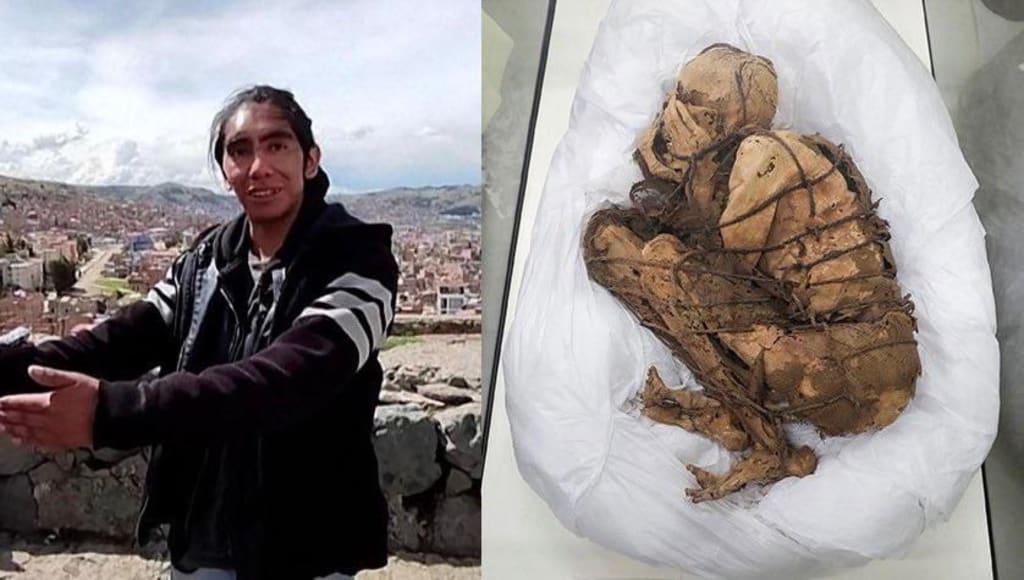The Curious Case of "Juanita": A Mummy and Her Modern-Day Companion
Funny lies

The Curious Case of "Juanita": A Mummy and Her Modern-Day Companion
In the annals of bizarre and extraordinary events, few stories can match the peculiar case that unfolded in Peru in 2023. Authorities detained a man who was found carrying an 800-year-old mummy in a travel bag. When questioned, the man claimed the mummy was named "Juanita" and, astonishingly, referred to her as his girlfriend. This unusual event has sparked a mix of intrigue, humor, and scholarly interest worldwide, highlighting the intersection of archaeology, law, and human eccentricity.
The Unfolding of Events
The incident occurred in Puno, a city near the shores of Lake Titicaca, a region steeped in rich historical and cultural significance. The Peruvian National Police were conducting routine patrols when they encountered a visibly nervous man clutching a large travel bag. Suspicious of the man's behavior, officers decided to investigate further. Their initial inspection of the bag revealed an astonishing discovery: inside lay the well-preserved remains of an ancient mummy.
The man, identified as Julio Cesar, provided an explanation that only added to the bewilderment. He claimed that the mummy, which he referred to as "Juanita," was his girlfriend. According to Cesar, he had been in a "relationship" with Juanita for several years and had even taken her on various outings. His statements, while peculiar, were delivered with such conviction that authorities had to delve deeper into the background of both Cesar and the mummy.
Who Was "Juanita"?
"Juanita," as Cesar affectionately called the mummy, is believed to be around 800 years old. Preliminary analyses suggest that the mummy likely dates back to the pre-Columbian era, possibly belonging to the Inca or one of the earlier Andean civilizations. The preservation of the mummy indicates sophisticated embalming techniques that were used in ancient Peru, where mummification was a common practice to honor the dead and prepare them for the afterlife.
Mummies in this region were often buried with artifacts, textiles, and offerings, signifying their status and the beliefs of their communities. The discovery of Juanita adds another piece to the complex puzzle of ancient Andean cultures, providing valuable insights into their funerary practices and social structures.
The Legal and Ethical Dilemmas
The discovery of Juanita in such an unconventional context raised numerous legal and ethical questions. In Peru, the removal and possession of cultural artifacts, including human remains, are strictly regulated by law. Such items are considered national heritage and are protected to ensure their preservation for future generations. Julio Cesar's actions, therefore, constituted a serious violation of these regulations.
Cesar's explanation that he had found Juanita in his family home and decided to keep her as a companion further complicated the situation. While his story was met with skepticism, it prompted authorities to investigate the origins of the mummy and how it had come into Cesar's possession. The possibility of looting or illegal excavation was a significant concern, as the illicit trade in antiquities remains a persistent issue in Peru and other countries with rich archaeological legacies.
Psychological and Sociological Perspectives
Julio Cesar's belief that Juanita was his girlfriend opens a window into the psychological and sociological dimensions of the case. From a psychological standpoint, his attachment to the mummy might be understood through the lens of delusional disorder or necrophilia, conditions that involve strong, often romantic, feelings toward deceased individuals. Alternatively, his statements could be interpreted as a coping mechanism for loneliness or social isolation.
Sociologically, the case sheds light on the broader phenomenon of human attachment to inanimate objects or historical artifacts. Such attachments can stem from a variety of factors, including personal loss, cultural fascination, or a desire for connection. In Cesar's case, his "relationship" with Juanita might reflect a deeper, albeit unconventional, need for companionship and meaning.
The Archaeological and Cultural Impact
While the sensational aspects of the story have captured public attention, the archaeological significance of Juanita should not be overlooked. The mummy represents an important link to Peru's ancient past, offering a tangible connection to the practices and beliefs of long-gone civilizations. Her discovery in a modern-day context underscores the ongoing relevance of archaeology in uncovering and preserving human history.
Experts in the field have expressed a desire to study Juanita further, aiming to glean more information about her origins, the circumstances of her preservation, and the culture she belonged to. This research has the potential to enrich our understanding of pre-Columbian societies and contribute to the broader narrative of human history.
Moving Forward
In the aftermath of the discovery, authorities have taken steps to ensure the proper handling and preservation of Juanita. The mummy has been transferred to a specialized archaeological facility where experts can conduct a thorough examination. This process will involve not only scientific analysis but also careful consideration of ethical guidelines to respect the cultural significance of the remains.
For Julio Cesar, the outcome remains uncertain. While his actions have clearly violated legal statutes, there is a growing recognition that his case also involves complex psychological and social elements. As such, a nuanced approach that addresses both the legal and human aspects of the situation is warranted.
Conclusion
The story of Juanita and her modern-day "companion" Julio Cesar is a fascinating intersection of ancient history and contemporary life. It highlights the enduring allure of the past and the sometimes surprising ways in which individuals connect with history. As the world continues to unravel the mysteries surrounding Juanita, her story serves as a poignant reminder of the intricate tapestry of human experience, where the past and present are inextricably linked.
About the Creator
Enjoyed the story? Support the Creator.
Subscribe for free to receive all their stories in your feed. You could also pledge your support or give them a one-off tip, letting them know you appreciate their work.






Comments
There are no comments for this story
Be the first to respond and start the conversation.